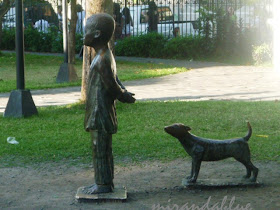
Here's a beautiful native Philippine red pineapple I stumbled at the forest in Tayabas. In 2007, Philippines was the second in the world production of pineapple at 233 metric tons. Costa Rica was number 1, and Cote d'Ivoire came third. Aside from puree, juice concentrates, canned products, dried and fruit cocktail, native Philippine red pineapple is also an excellent source of pina fiber.
But do you know how the pineapple got a skin covering that resembles a human eye?
There's a myth that most Filipino children must have heard while seated at her or his grandmother's lap. It started with a farm girl named Pina who lived with her mom as tenants in a fruit plantation. Her mom was the hard-working type, and Pina was also hard-working---but not with the household chores. She loved playing all the time. The myth goes on to say that the mother, used to being too vocal with her careless ill wishes or curses on people who didn't delight her, was liberal on such habit on her daughter, Pina.
One day, the myth says, Pina’s procrastinations went too far for her mom to tolerate them anymore. The mother told Pina to get her wooden shoes from the under their hut. Pina went down their hut and looked under it. But on seeing her old rag doll, Pina's imagination started working. She was soon playing with the doll and forgot all about her task. Her usual dialogue of “I didn't see it,” when actually she wasn’t searching but playing, did it this time. Her mom shouted invectives at her and a curse---“May you grow dozens of eyes!” so Pina would stop mentioning her favorite dialogue. Then suddenly, Pina disappeared.
A search party looked all over the plantation for Pina but they couldn't find her. Then Pina’s mom saw a curious new plant growing at their backyard. It was covered with eyes. She remembered her latest curse on Pina and knew the plant was her. From then on, she called the plant, a pineapple, or “Pinya” in Filipino.
The myth on the origin of pineapple aims at fostering obedience, and that parents ought to watch how they deal with their kids.
Posted for Ruby Tuesday
.gif)


.gif)









































.gif)











